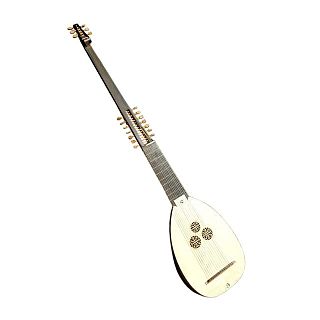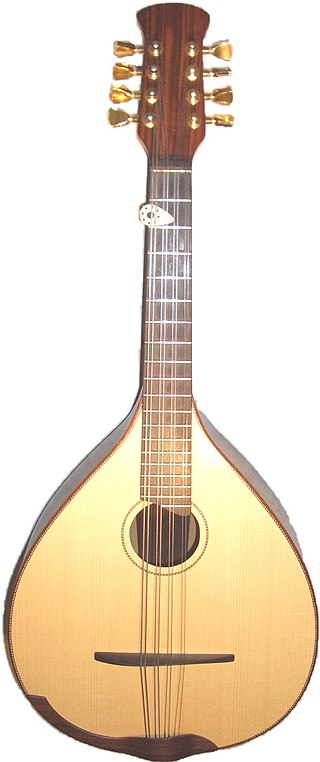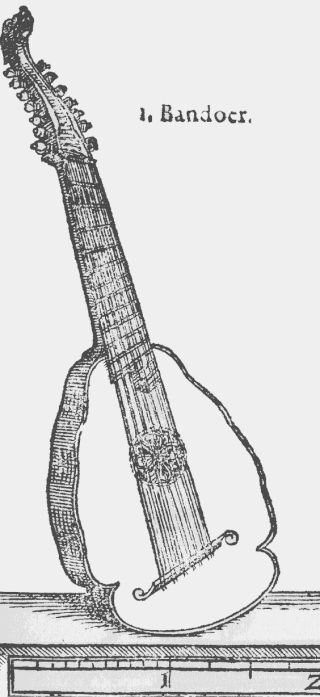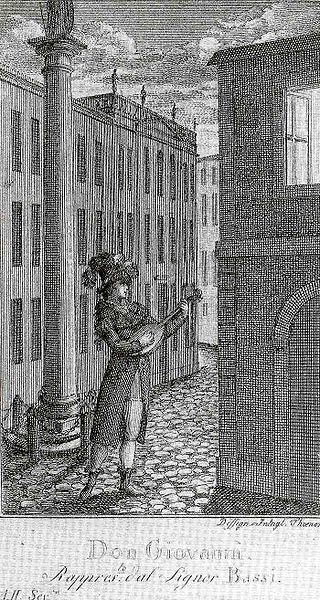- Mandora or Gallichon
- Gallichon
The mandora or gallichon is a type of 18th- and early 19th-century lute, with six to nine courses of strings. The terms were interchangeable, with mandora more commonly used from the mid-18th century onwards.
The mandora or gallichon is a type of 18th- and early 19th-century lute, with six to nine courses of strings. The terms were interchangeable, with mandora more commonly used from the mid-18th century onwards.

Mandora or gallichon generally refers to a bass lute from the 1700s, with a vibrating string length of 72 centimeters or greater, used in Germany and Bohemia. It could be either single- or double-strung. [3]
James Tyler pointed out in his book The Early Mandolin that the word mandora was rarely encountered before the 18th century. [4] Then, it referred to a large bass lute. [4] The gallichone, as it was better known, [4] was a type of 6 or 8-course bass lute (possibly a descendant of the guiterne and/or chitarra italiana [5] ) used, mainly for basso continuo, in Germany, Austria and Bohemia particularly during the 18th and early 19th centuries. [6] It was also called the galizona,galichon or caledon. Tyler disputed that it was mainly used for continuo, saying it was used "both as a solo and as a continuo instrument". [4] The instrument was popular in the 18th century and there are various surviving instruments and manuscript sources (see below), mainly from Germany. The mandora often had only 6 courses, resulting in a simpler technique than the complex and difficult 13-course lute, so was more suitable for amateur players. Similar instruments were also in use in northern Italy, although generally referred to as "liuto" (lute) rather than mandora.
Composers for the gallichon/mandora include Johann Paul Schiffelholz and Telemann, as well as Ruggero Chiesa in the modern era (1933-1993). Chiesa called the instrument the colascione, incorrectly as the colascione is a different instrument. Gottfried Finger suggested that it was used in Boheman musical circles. [3] The mandora was still in use in the early 19th century, particularly in Vienna and the Bavarian town Eichstätt. The Viennese guitarist Simon Molitor mentions the mandora several times in his early 19th century writings [7] and says that by that time mandoras had 8 single strings.
The bass type, similarly to the theorbo and other baroque lutes, has a vaulted body (shell) constructed of separate ribs, a flat soundboard with either a carved rose or one which is inset into the soundhole, and a bridge (without a saddle) consisting of a wooden bar acting as a string-holder glued to the soundboard. Unique to this instrument is the neck, which is long enough to allow for ten to 12 tied gut frets. The pegbox is either straight and set at a sharp angle to the neck (much like a lute pegbox), or gently curving and set at a shallow angle, either case being fitted with laterally-inserted tuning pegs (although sometimes a flat pegboard with sagittal pegs is found). The strings were of gut and are strung either singly or, especially on Italian instruments, in double courses. However, on German-made instruments, the first course (highest in pitch) is usually single (a chanterelle) and often has its own separate raised peg rider/holder attached to the pegbox. The number of courses varies from six to eight. Open string lengths tend to be fairly long (62–72 cm) on German instruments, but shorter (55–65 cm) on late Italian ones, probably because they tended to be tuned to a higher pitch.
Luthiers who produced mandoras in the first half of the 18th century were Gregor Ferdinand Wenger in Augsburg, Jacob Goldt of Hamburg, Jacob Weiss of Salzburg, David Buchstetter of Regensburg and Mattias Greisser of Innsbruck. Italian-style instruments are represented by Martino Hell of Genoa, Enrico Ebar of Venice, David Tecchler of Rome, Antonio Scoti of Milan and, toward the end of the century, Antonio Monzino and Giuseppe Presbler of Milan.
At least 50 original instruments survive in collections around the world. Examples are found in museums in Berlin, Claremont (California), Copenhagen, Edinburgh, The Hague, Leipzig, Milan, Munich and Paris, New York and St. Petersburg. Many of these instruments are found in a more or less unaltered state, and therefore are often used as models for modern reconstructions.
In the 18th century, mandora was the name of a six-course lute instrument of about 70 cm string length, tuned high-to-low d' - a - f - c - G - F or e' - b - g - d - A - E (rarely with two or three additional bass courses). With the former tuning, the instrument was called Calichon or Galichon in Bohemia.
Around 1800, a mutual interchange between the mandora and the guitar took place. The guitar, which had so far been tuned in re-entrant tuning (e' - b - g - d' - a), took over the 6th course and the tuning of the mandora (e' - b - g - d - A - G, later also e' - b - g - d - A - E), whereas the mandora took over the stringing with single strings instead of courses, as had been introduced to the guitar. The so-called wandervogellaute has been a late heir to that development.
From another source on tuning:
Two tunings are reported: a ‘galizona’ or ‘colachon’ is tuned A'( or ) –B'( or ) –C–D–G–c–e–a, and, under a separate heading, ‘mandora’ is given as D ( or ) –E ( or ) –F–G–c–f–a–d' (i.e. the same tuning but a 4th higher) or E–A–d–g–b–e' (identical to that of the modern guitar)
The playing technique for the mandora involves the same basic right-hand finger style as for all 18th-century lutes and, because of the tuning intervals of the upper five courses, a left-hand technique that is similar to that of the 18th-century guitar.
There are about 55 sources of mandora music in tablature, all in manuscript (none printed) and nearly all of Germanic origin. These contain solos, duets, song accompaniments, and chamber music. Few studies have appeared and very little of the music has been transcribed and published: critical editions are especially rare. Many have no composers attributed but in recent years studies of concordances are beginning to uncover music by composers such as Silvius Leopold Weiss and Johann Anton Logy. The sources do mention some composers' names; Duke Clement of Bavaria, Placidus von Camerloher , Johann Paul Schiffelholz, Joseph (Josef) Michael Zink, Andrea Mayr, Giuseppe Antonio Brescianello and others. Other composers include Georg Philipp Telemann who wrote 6 concerti for flute, gallichon and strings, Johann Friedrich Daube and Johann Albrechtsberger, whose three concertinos for ‘mandora’, ‘crembalum’ (jaw harp) and strings have been performed and recorded. Today there are various modern lutenists who play the mandora and some of these historical works have been recorded. The mandora has also been used in contemporary music, the British lutenist and composer Chris Hirst uses the mandora extensively in his works, often in combination with diverse instruments like the cello, cor anglais and melodica. [8]
... It was probably originally made for seven or eight courses (pairs) of strings, but in the seventeenth century the neck, bridge, and pegbox were replaced or modified to give the instrument a Baroque configuration. In the nineteenth century, the neck was reduced, fixed frets were added, and the instrument was changed to six-strings, like on a guitar. ...

The classical guitar, also called Spanish guitar, is a member of the guitar family used in classical music and other styles. An acoustic wooden string instrument with strings made of gut or nylon, it is a precursor of the modern steel-string acoustic and electric guitars, both of which use metal strings. Classical guitars derive from the Spanish vihuela and gittern of the 15th and 16th century. Those instruments evolved into the 17th and 18th-century baroque guitar—and by the mid-19th century, early forms of the modern classical guitar. Today's modern classical guitar was established by the late designs of the 19th-century Spanish luthier, Antonio Torres Jurado.

A lute is any plucked string instrument with a neck and a deep round back enclosing a hollow cavity, usually with a sound hole or opening in the body. It may be either fretted or unfretted.
A mandolin is a stringed musical instrument in the lute family and is generally plucked with a pick. It most commonly has four courses of doubled strings tuned in unison, thus giving a total of eight strings. A variety of string types are used, with steel strings being the most common and usually the least expensive. The courses are typically tuned in an interval of perfect fifths, with the same tuning as a violin. Also, like the violin, it is the soprano member of a family that includes the mandola, octave mandolin, mandocello and mandobass.

The theorbo is a plucked string instrument of the lute family, with an extended neck that houses the second pegbox. Like a lute, a theorbo has a curved-back sound box with a flat top, typically with one or three sound holes decorated with rosettes. As with the lute, the player plucks or strums the strings with the right hand while "fretting" the strings with the left hand.

The mandola (US and Canada) or tenor mandola (Ireland and UK) is a fretted, stringed musical instrument. It is to the mandolin what the viola is to the violin: the four double courses of strings tuned in fifths to the same pitches as the viola (C3-G3-D4-A4), a fifth lower than a mandolin. The mandola, though now rarer, is an ancestor of the mandolin. (The word mandolin means little mandola.)

The cittern or cithren is a stringed instrument dating from the Renaissance. Modern scholars debate its exact history, but it is generally accepted that it is descended from the Medieval citole. Its flat-back design was simpler and cheaper to construct than the lute. It was also easier to play, smaller, less delicate and more portable. Played by people of all social classes, the cittern was a popular instrument of casual music-making much like the guitar is today.
Scordatura is a tuning of a string instrument that is different from the normal, standard tuning. It typically attempts to allow special effects or unusual chords or timbre, or to make certain passages easier to play. It is common to notate the finger position as if played in regular tuning, while the actual pitch resulting is altered. When all the strings are tuned by the same interval up or down, as in the case of the viola in Mozart's Sinfonia Concertante for Violin, Viola and Orchestra, the part is transposed as a whole.

The bandora or bandore is a large long-necked plucked string-instrument that can be regarded as a bass cittern though it does not have the re-entrant tuning typical of the cittern. Probably first built by John Rose in England around 1560, it remained popular for over a century. A somewhat smaller version was the orpharion.

The bandurria is a plucked chordophone from Spain, similar to the mandolin and bandola, primarily used in Spanish folk music, but also found in former Spanish colonies.

A course, on a stringed musical instrument, is either one string or two or more adjacent strings that are closely spaced relative to the other strings, and typically played as a single string. The strings in each multiple-string course are typically tuned in unison or an octave.

The gittern was a relatively small gut-strung, round-backed instrument that first appeared in literature and pictorial representation during the 13th century in Western Europe. It is usually depicted played with a quill plectrum, as can be seen clearly beginning in manuscript illuminations from the thirteenth century. It was also called the guiterna in Spain, guiterne or guiterre in France, the chitarra in Italy and Quintern in Germany. A popular instrument with court musicians, minstrels, and amateurs, the gittern is considered an ancestor of the modern guitar and other instruments like the mandore, bandurria and gallichon.
The Ceterone (Italian), was an enlarged cetera, believed to be similar to the chitarrone as a development of the chitarra and lute to enhance the bass capabilities of these instruments.

The angélique is a plucked string instrument of the lute family of the baroque era. It combines features of the lute, the harp, and the theorbo.

The dramyin or dranyen is a traditional Himalayan folk music lute with six strings, used primarily as an accompaniment to singing in the Drukpa Buddhist culture and society in Bhutan, as well as in Tibet, Ladakh, Sikkim and Himalayan West Bengal. It is often used in religious festivals of Tibetan Buddhism. The instrument is played by strumming, fingerpicking or plucking. The dramyen, chiwang (fiddle), and lingm (flute) comprise the basic instrumental inventory for traditional Bhutanese folk music.

The mandore is a musical instrument, a small member of the lute family, teardrop shaped, with four to six courses of gut strings and pitched in the treble range. Considered a French instrument, with much of the surviving music coming from France, it was used across "Northern Europe" including Germany and Scotland. Although it went out of style, the French instrument has been revived for use in classical music. The instrument's most commonly played relatives today are members of the mandolin family and the bandurria.
Johann Paul Schiffelholz, was a German Baroque composer and an important composer for the variety of baroque lute called "calichon" or "gallichona" or "mandora" - not to be confused with the Italian "colascione" - as well as writing the usual trio sonatas, etc., for the violin family of instruments. He was born in Heideck.

The colascione is a plucked string instrument from the late Renaissance and early Baroque periods, with a lute-like resonant body and a very long neck. It was mainly used in southern Italy. It has two or three strings tuned in fifths.

Lutes are stringed musical instruments that include a body and "a neck which serves both as a handle and as a means of stretching the strings beyond the body".

The mandolin is a modern member of the lute family, dating back to Italy in the 18th century. The instrument was played across Europe but then disappeared after the Napoleonic Wars. Credit for creating the modern bowlback version of the instrument goes to the Vinaccia family of Naples. The deep bowled mandolin, especially the Neapolitan form, became common in the 19th century, following the appearance of an international hit, the Spanish Students. They toured Europe and America, and their performances created a stir that helped the mandolin to become widely popular.

Domenico Colla was an 18th-century Brescian composer and performer who traveled Europe in the 1760s, performing in the most important theaters and salons. Together with his brother Giuseppe, he was one of the Signori Colla, or the Colla brothers. The brothers played in royal circles; they performed before Frederick the Great in 1765 in the palace at Sanssouci. They were in London in 1766, where it was advertised that they had performed before the British royalty, as well as other the royal families of Europe. The brothers were also noted for being survivors of slavery in Algiers, rescued from it by the King of Poland.